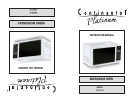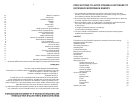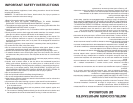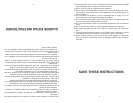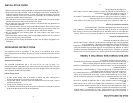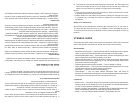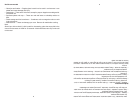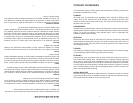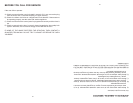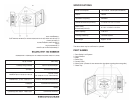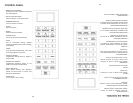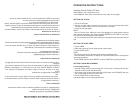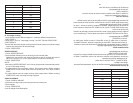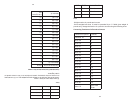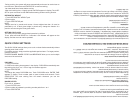5
5
b. El cable de extensión debe ser un cable a tierra de tres puntas y el cable más
largo debe estar arreglado de tal manera que no cuelgue sobre la mesa o barra
donde pueda ser halada por niños o tropezada.
Notas:
1. Si tiene alguna pregunta sobre la conexión a tierra o las instrucciones eléctri-
cas, consulte un electricista calicado o persona de servicio.
2. Ni Kalley o el distribuidor pueden aceptar culpabilidad por daños ocasionados
al horno o lesiones personales resultantes de la falta de observación de los
procedimientos de conexión eléctricas.
Interferencia de Radio o TV
Si observa alguna interferencia a su radio o TV causada por el horno microondas, re-
vise que el horno microondas esté en un circuito diferente, cambio el lugar de la radio o
la TV tan lejos sea posible del horno o revise la posición y señal de la antena.
GUÍA DE UTENSILIOS
Esta sección lista qué utensilios pueden ser usados en el microondas, cuáles tienen
un uso limitado por periodos cortos y cuáles no deben ser usados en el microondas.
Recommended
• Plato para dorar en el microondas – Utilice para dorar el exterior de ítems pequeños
como bistec, chuletas o pancakes. Siga las instrucciones suministradas con su plato
para dorar.
• Cobertura de plástico para microondas – Utilice para retener el vapor. Deje una
pequeña apertura para que algo del vapor escape y evite colocarlos directamente
sobre la comida.
• Toallas de papel y servilletas – Utilice para calentamiento de corto tiempo y cober-
tura. Estos absorben el exceso de humedad y previenen salpiques. No utilice toallas
de papel reciclados, que pueden contener metal y pueden incendiarse.
• Vidrio y lozas de vidrio/cerámica – Utilice para calentar o cocinar.
• Platos y vasos de papel – Utilice para calentamiento de corto tiempo a temperaturas
bajas. No utilice papel reciclado, que pueden contener metal y pueden incendiarse.
• Papel parana – Utilícelo como cubierta para evitar salpiques.
• Termómetros – Utilice sólo aquellos marcados “Microwave Safe/Seguros para mi-
croondas” y siga las instrucciones. Revise la comida en varios lugares. Termómetros
convencionales pueden ser usados en comida de microondas una vez la comida se
haya retirado del horno.
Uso limitado
• Papel aluminio – Utilice pedazos angostos de papel aluminio para prevenir sobre
cocción de áreas expuestas. Usar mucho aluminio puede dañar su horno, entonces
tenga cuidado.
• Cerámica, porcelana y gres – Utilícelos si están marcados “Microwave Safe/Seguros
b) The extension cord must be a grounding-type 3-wire cord, and The longer cord
should be arranged so that it will not drape over the counter top or table top
where it can be pulled on by children or tripped over unintentionally.
Notes:
1. If you have any questions about the grounding or electrical instructions, consult
a qualied electrician or service person.
2. Neither Galanz nor the dealer can accept any liability for damage to the oven
or personal injury resulting from failure to observe the electrical connection
procedures.
Radio or TV Interference
Should there be any interference caused by the microwave oven to your radio or
TV, check that the microwave oven is on a different circuit, relocated the radio or
TV as far away from the oven as feasible or check position and signal of receiving
antenna.
UTENSILS GUIDE
This section lists which utensils can be used in the microwave, which ones have limited
use for short periods, and which ones should not be used in the microwave.
Recommended
• Microwave browning dish — Use to brown the exterior of small items such as steaks,
chops, or pancakes. Follow the directions provided with your browning dish.
• Microwaveable plastic wrap — Use to retain steam. Leave a small opening for some
steam to escape and avoid placing it directly on the food.
• Paper towels and napkins — Use for short-term heating and covering; these absorb
excess moisture and prevent spattering. Do not use recycled paper towels, which
may contain metal and could ignite.
• Glass and glass-ceramic bowls and dishes — Use for heating or cooking.
• Paper plates and cups — Use for short-term heating at low temperatures. Do not use
recycled paper, which may contain metal and could ignite.
• Wax paper — Use as a cover to prevent spattering.
• Thermometers — Use only those labeled “Microwave Safe” and follow all
directions. Check the food in several places. Conventional thermometers may be used on
microwave food once the food has been removed from the oven.
Limited use
• Aluminum foil — Use narrow strips of foil to prevent overcooking of exposed areas.
Using too much foil can damage your oven, so be careful. You should keep distance
of 1 inch (2.54cm) between aluminum foil and cavity.
• Ceramic, porcelain, and stoneware— Use these if they are labeled “Microwave Safe”.
If they are not labeled, test them to make sure they can be used safely.
• Plastic — Use only if labeled “Microwave Safe”. Other plastics can melt.



